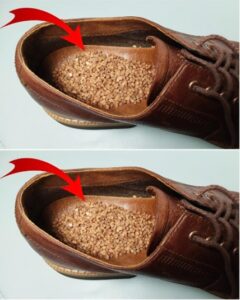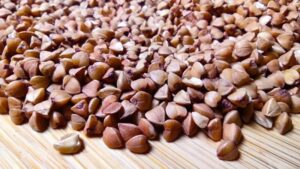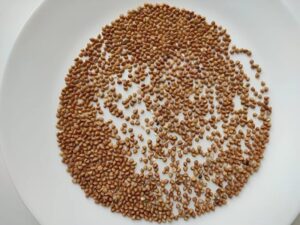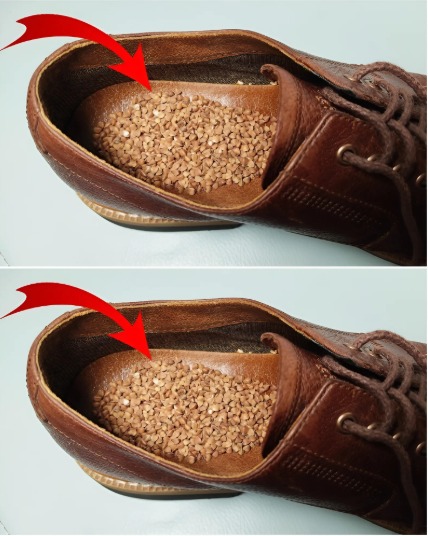In my household, buckwheat has always held a special place on the dining table. For generations, it has been a versatile staple that could be enjoyed in a variety of ways—whether stirred into a warm bowl of milk, paired with meat for a hearty dish, or simply enriched with a small pat of butter. For the longest time, I assumed that buckwheat’s usefulness began and ended in the kitchen. To me, it was nothing more than a nourishing grain, valued for its taste and health benefits.
But much to my surprise, this humble grain holds an astonishing secret that reaches far beyond the realm of cooking. I recently discovered that some people have been using buckwheat in a completely different and unexpected way: they actually place it inside their footwear!
At first, I couldn’t help but think the idea was rather strange—almost impractical. However, curiosity got the better of me, and I began to investigate further. What I found completely changed my perspective. As it turns out, this isn’t just some quirky folk habit; it’s an age-old, clever technique that has quietly been passed down through the years. And once I understood its real benefits, I became convinced that this underappreciated tradition deserves much more recognition. That’s why I’m excited to share this fascinating discovery with you.

A Tradition Handed Down Through the Ages
The custom of using buckwheat in shoes is not new—it actually dates back many decades, if not centuries. In the past, footwear was often made from coarse, rigid materials that didn’t bend easily and could take a long time to break in. Walking in them was uncomfortable, sometimes even painful. Out of necessity, people came up with a brilliant solution: they started using buckwheat inside their shoes.
Not only was it an inexpensive and natural method, but it also significantly improved comfort for everyday wear. And over time, people realized that buckwheat didn’t just soften stiff shoes; it also provided other surprising advantages for both footwear and foot health.
Why Would Anyone Put Buckwheat in Their Shoes?
1. Natural Moisture Absorption and Odor Removal
One of the most impressive properties of buckwheat is its ability to absorb excess moisture. This makes it a lifesaver during damp, chilly winters when shoes are more likely to become wet. If your footwear ever feels soggy or starts developing an unpleasant odor, you can simply sprinkle some buckwheat inside and leave it overnight. By the following morning, the shoes will be dry, refreshed, and free from lingering smells.
2. Gentle Massage and Soothing Relief
Health experts and podiatrists often recommend walking on uneven or textured surfaces—such as bottle caps or small stones—to stimulate circulation in the feet. While effective, those methods can be rough and uncomfortable. Buckwheat, on the other hand, provides a softer, more pleasant alternative. By adding the grains to your slippers and walking around indoors, you can enjoy a subtle, relaxing massage effect. The gentle pressure promotes blood flow and relieves tension, while still feeling comfortable underfoot.
3. Warmth and Comfort in Cold Weather
Another time-tested trick from rural communities is to gently heat buckwheat in a skillet and then place it inside shoes. Thanks to its natural ability to retain heat for extended periods, the grains act like a miniature heater, keeping your feet toasty even during extremely cold conditions. It may sound like nothing more than an old-fashioned experiment, but science supports the idea—it genuinely works to preserve warmth.

My Personal Experiment: Testing the Method Myself
Given how many people have relied on this method for generations, I decided to try it firsthand. I dug out an older pair of slippers I keep around the apartment, poured some buckwheat inside, and began walking.
At first, the sensation was a little odd—it felt like stepping on tiny pebbles. But unlike actual stones, it wasn’t painful or irritating, just unfamiliar. After a few minutes, something surprising happened: my feet began to feel noticeably more relaxed, as though they were being lightly massaged. Encouraged by this effect, I decided to test buckwheat’s moisture-absorbing property too.
That night, I placed buckwheat into a pair of sneakers that had become slightly damp. By the next morning, the results spoke for themselves—the shoes were dry, fresh, and even the insoles seemed revitalized.
Would I recommend trying this? Without a doubt—absolutely yes.
The Hidden Secret Revealed: Buckwheat as the Ultimate Footcare Hack
When a method manages to survive through generations, there’s usually a good reason behind it. The tradition of using buckwheat in shoes is no exception—it works, and it works well.
Whether you’re searching for a simple way to give your feet a soothing massage, hoping to get rid of stubborn shoe odors and moisture, or looking for a natural way to keep your feet warm in the cold, buckwheat offers an effective solution. With just a handful of grains, you can transform ordinary shoes into something more comfortable and beneficial.

I’ll never look at buckwheat the same way again. It may still be a staple in my kitchen, but now I also see it as a clever, multi-purpose tool for comfort and foot health. So the next time you happen to notice someone slipping buckwheat into their footwear, don’t laugh—it just means they’re ahead of the curve, already in on a little secret that deserves to be shared.


